English Spelling Rules With Examples: In this article, I have prepared a lesson to help you with your spelling. Spelling is really frustrating, even for native speakers, proficient learners, for lots of people. Unlike with some other languages, it isn’t always possible to predict how to spell an English word based on how it sounds, and vice versa. You can’t always predict how to pronounce an English word based on how it’s spelt or written.
However, I do have some good news for you. English spelling does have several rules and although there are always exceptions, the majority of words do follow these patterns.
English Spelling Rules With Examples
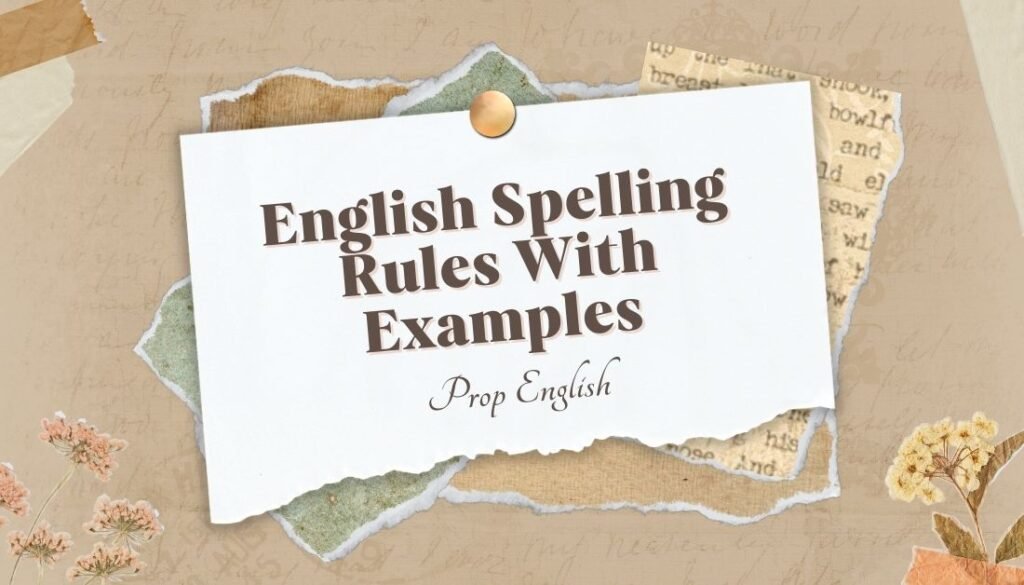
I know that many of us have predictive text and spell checkers that highlight spelling errors and can help prevent embarrassing mistakes, but it is still worth dedicating a little bit of time to learning some spelling rules. So, I have put together 5 super helpful tips that will allow you to improve your spelling in no time at all.
I have also included a good old-fashioned spelling test, so you might want a pen or paper with you. Let’s get started with the lesson.
1. Spelling Rule: ‘iec’ and ‘cie
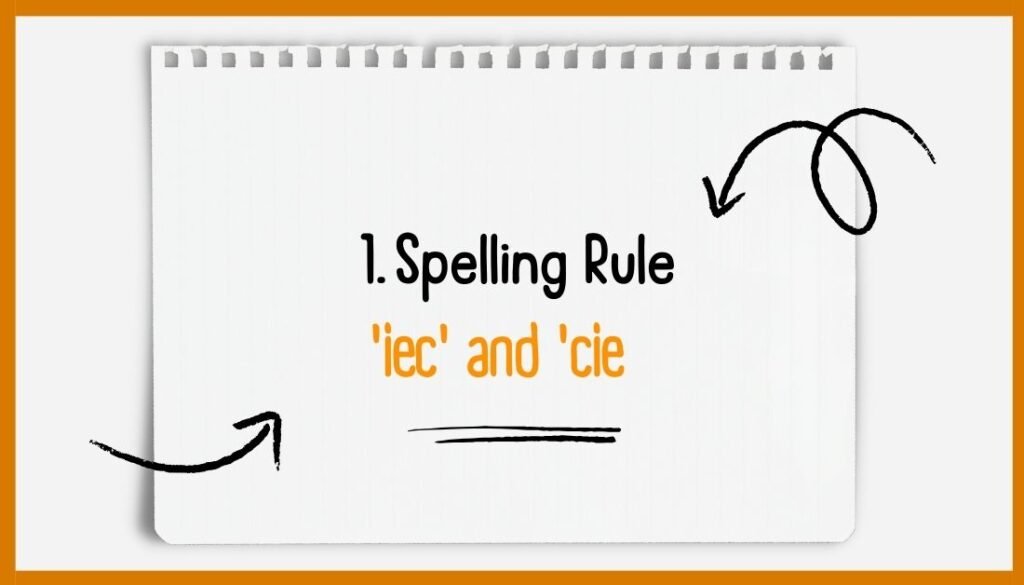
Our first spelling rule is I before E except after C and E before I after the C
1. ‘i’ before ‘e’ except before ‘c’
Well, when we write a word with the letters I and E next to each other, we usually put the I first. In this rule sometimes we get ‘c’ in the word. That means in this rule ‘c’ will not always be there. For example:
- patient
- client.
- friend
- niece
- thief
- review.
2. ‘i’ before ‘e’ except after ‘c’
The second part of this rule is except after C. This means that after the letter C, the order switches and we write EI. We saw this with the word receive. If the ‘c’ in the word then ‘i’ will be always after the ‘e’.
‘c’ comes first, so ‘i’ and ‘e’ switch and it’s ‘ei’. Some more examples are:
- receipt
- perceive
- deceit
- ceiling.
Exceptions of ‘ei’ and ‘cie’
Now, this is English, and there are always exceptions. Look at these words:
- caffeine, which is spelled EI.
- the word scientist, which is spelt CIE, even though the rule is I before E except after C.
I’m going to give you some more examples of exceptions to this rule
| ei | cie |
| caffeine | scientists |
| weird | society |
| foreign | ancient |
| protein | efficient |
| height | |
| their | |
| Neil |
Now, that might seem like a lot of exceptions. Out of all the rules I’m going to teach you for now, this is perhaps the one that has the most exceptions. [english spelling rules with examples]
2. Spelling Rule: ‘consonant + y’ into ‘I + suffix‘
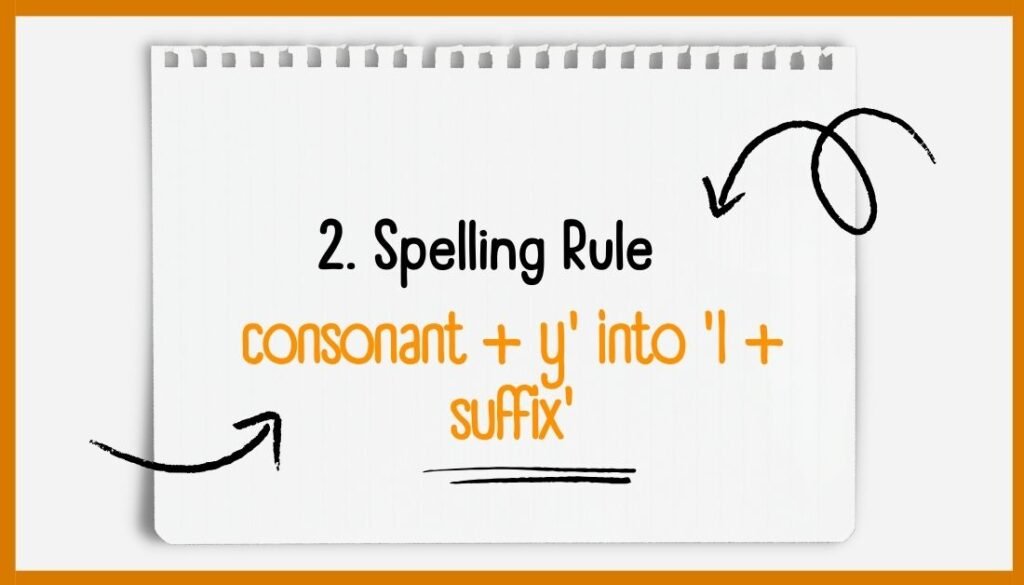
In English, we have five vowels, A, E, I, O and U. All of the other letters are consonants apart from Y, which can be controversial. That’s not important here.
1. End in consonant + y, y into i
The second spelling rule I want to show you is this. If a word ends in a consonant + the letter Y, we change the Y into I before adding a suffix.
A suffix is a letter or letters added to the end of a word to create a new word.
For example: Butterfly ends in the consonant L + the letter Y. So if we want to make the word plural, we need to change the Y into I before adding the suffix -ES.
- Butterfly – es
Notice how we need to add -ES to form the plural of this word, not just S on its own.
- butterflys: This is wrong.
- butterflies: This is wrong.
- butterflies: This is correct.
2. End in consonant + y, for comparative forms
We also saw this change with the adjective pretty. Now, pretty ends in the consonant T plus Y, so the comparative and superlative forms are prettier and prettiest.
- Pretty, prettier, prettiest (We change the Y to I and then add the suffix).
Here are some more examples.
- Lucky + –LY, luckily
- Marry + AGE, marriage
- Try + ED, tried
- Cry + ES, cries
- party + ES, parties
Remember, with this rule, we add -ES, not just S on its own to form the plural and the third-person singular. Be careful when adding the suffix -ING, ing.
We don’t normally like to have ‘ii ‘together, so keep the ‘Y’ when adding –ING.
- Fly + -ING, flying, not fliiing
- Try + -ING, trying, not trying.
Exceptions: ‘ing’ into ‘iing’
Now, speaking of I’s, don’t forget to keep your eye out for exceptions. Yeah, in English, we even have exceptions to exceptions, and one of the most common is the word skiing, ski + -ING, skiing.
Remember, if a word ends in a vowel + Y, there is no need to change the letter Y.
For example: the following words, both end in a vowel plus Y, so the Y stays.
- Dismay + –ED, dismayed
- Subway + S, subways
Here are some more examples:
- jersey + S, jerseys
- buy + –S, buys
- survey + –ED, surveyed
Please be careful, though. There are several exceptions, which we can see with some very common AY words, for example:
- day + –ly, daily
- pay + –ed, paid
- say + –ed, said
Students also read: How to Use Apostrophes Properly: English Grammar Guide
3. Spelling Rule: Consonant Pattern before adding suffix
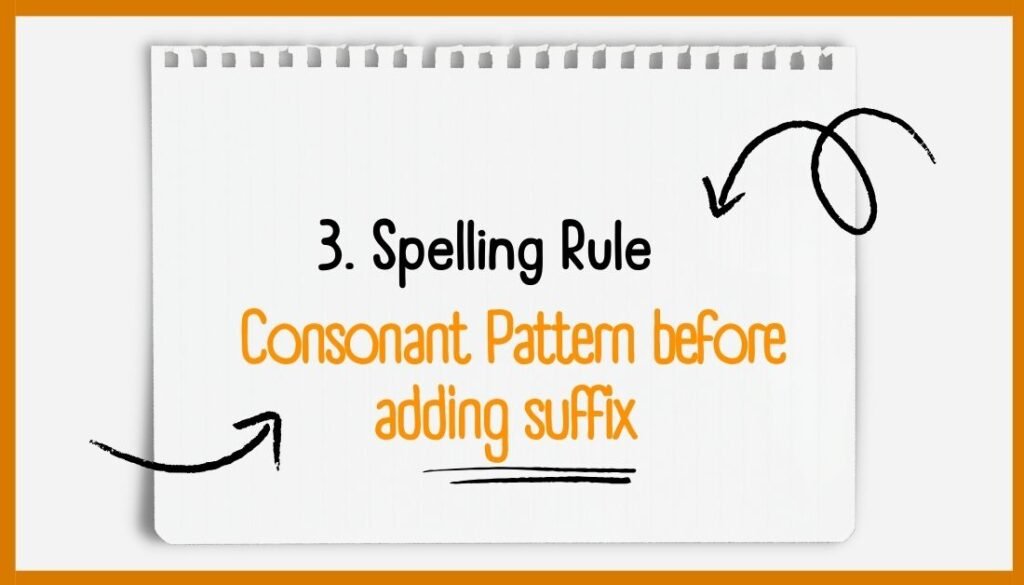
Our next spelling rule. When a word ends in a consonant + vowel + consonant pattern, we double the final consonant before adding a suffix.
Consonant + vowel + consonant is often shortened to CVC.
We usually do this with one-syllable words when we add a suffix that begins with a vowel. Some of the most common suffixes that begins with a vowel. [english spelling rules with examples]
Some of the most common suffixes here are:
- -ING
- -ED
- -ER
- -EST
1. The final consonant is doubled after adding the suffix
Let’s look at these two words: ‘winner and spotted’. The base or root forms of both these words end in a consonant, vowel, consonant, or CVC pattern.
So, the final consonant is doubled when we add a suffix beginning with a vowel. For example:
- Win + –ER, winner.
- Spot + –ED, spotted.
Some more common examples are:
- big + –er, bigger
- hot + –est, hottest
- rub + –ing, rubbing
- drop + –ed, dropped
- chat + – ed, chatted
2. Double the final consonant with suffix – ‘y’ ending
This rule also applies when adding the suffix -Y.
- mum + –y, mummy
- dad + –y, daddy
- sun + –y, sunny
3. When Suffix Begins with: ‘s’ or ‘ness’
Now, we don’t normally double the consonant when we add a suffix that begins with a consonant, for example, -S or -NESS.
- Plan + -S, plans.
- Fit + -NESS, fitness.
4. Double the final consonant with the second syllable
We also often double the final consonant with words that are stressed on the second syllable, for example:
- begin + –er, beginner
- upset + –ing, upsetting
- refer + –al, referral
5. No double consonant rule on the first syllable
We don’t usually double the consonant if the word is stressed on the first syllable, for example:
- offer + –ed, offered.
- visit + –or, visitor.
- open + -ing, opening.
Exceptions for British and American English
One important exception is that in British English, we sometimes double the final L, even when the stress is on the first syllable. [english spelling rules with examples]
In American English, a single L is generally preferred, for example:
| Word | British Egnlish | American English |
| travel + -er, | traveller | traveler |
| label + -ing, | labelling | labeling |
| cancel + -ed, | cancelled | canceled |
4. Spelling Rule: Drop of final ‘e’
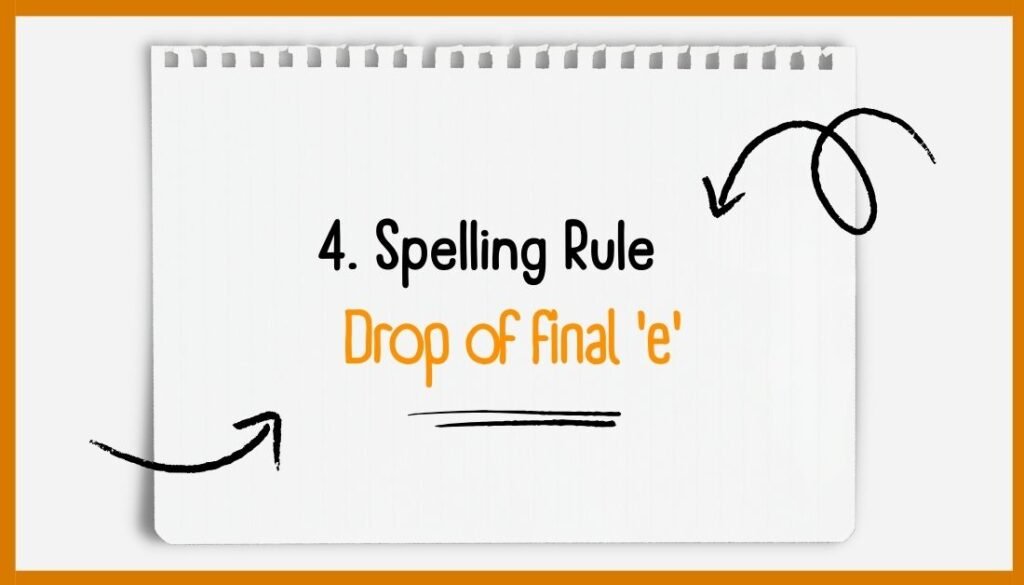
We don’t normally drop the final ‘e’ when adding a suffix that begins with a vowel. I have already mentioned some suffixes starting with a ‘vowel’. Such as:
- er
- est
- or
- ing
Let’s take an example:
- create + –or, creator
- use + –ing, using
- write + –er, writers
We don’t normally drop the ‘e’ if the suffix begins with a consonant. For example:
- free + –ly, freely
- use + –ful, useful
- agree + –ment, agreement
Exceptions: Alternative suffixes with a Drop of ‘e’
We also sometimes have alternative spellings to help us tell the difference between words. For example:
- argue + –ment, argument
- die + –ing, dying
- dye + –ing, dyeing
5. Spelling Rule: Same Spelling but Different Pronunciation
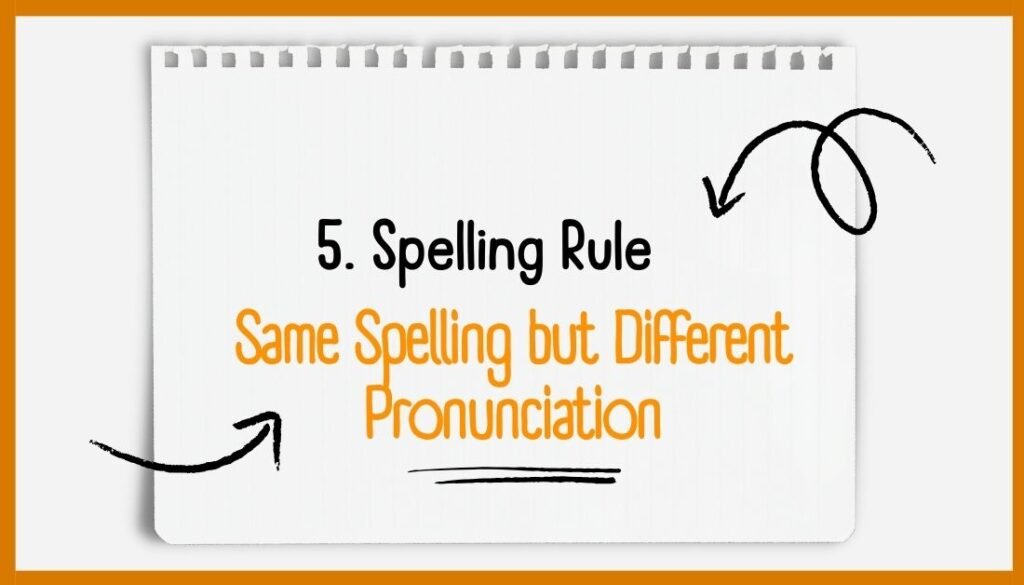
Now, I am super excited about rule number 5, because to explain it, we’re going to have to take a brief dive into pronunciation, my favorite topic.
1. Short pronunciation
Normally, when a word has a CVC or (consonant-vowel-consonant pattern), the vowel in the middle is pronounced with a short sound. For example:
- hat /hæt/
- win /wɪn/
- not /nɒt/
- hug /hʌɡ/
2. Silent ‘e’
If there is a silent ‘e’ at the end of the word, the vowel sound changes and is pronounced the same as the letter from the alphabet- A, E, I, O, U.
- hat /hæt/ → hate /heɪt/
- win /wɪn/ → wine /waɪn/
- not /nɒt/ → note /nəʊt/
- hug /hʌɡ/ → huge /hjuːdʒ/
So, the A in hat becomes the A in hate, the E in pet becomes the E in Pete, the I in win becomes the I in wine, the O in not becomes the O in note, and the A in hug becomes the U in huge.
That is the coolest rule ever. This spelling rule can really help you, especially if you hear the word before you’ve ever seen it written. [english spelling rules with examples]
Tips for learning English spellings

I have a couple more tips I’m going to go through super quickly because they are going to help you make big improvements to your spelling accuracy.
1. Tip: learn common consonant clusters.
English is jam-packed with consonant clusters and a consonant cluster is a group of consonants with no vowel in between.
It’s a really good idea to learn how to spell and recognise common clusters like GHT.
We find this cluster in many irregular past simple and past participle forms, such as
- bought
- thought
- caught
- fought
- right
- tonight
- eight
- height
Notice how the letters GH are not pronounced, they are silent, and this can make spelling these words correctly particularly challenging.
We have so many silent letters in English. Knowing those silent letters will help you with your pronunciation accuracy as well.
2. Tip: American or British?
My final tip for you is to be aware of the differences in American and British spelling. We’ve already seen an example of this with the words that ended in L, travelled, for example, but there are quite a few more differences that I would like to draw your attention to.
It doesn’t really matter which spelling you choose, but you should try to be consistent, especially if you’re taking a formal exam.
Here are some common differences.
Firstly, in American English, most people tend to drop the U in words that are spelled with the letters O-U-R in British English, for example:
| British – OUR | American – OR |
| colour | color |
| favour | favor |
| neighbourhood | neighborhood |
Secondly, in American English, a ‘z’ (zed) as we would call it, or a ‘z’ (zee) as Americans call it, often replaces the ‘s’ in many words ending in I-S-E in British English, for example:
| British – ISE | American – IZE |
| organise | organize |
| analyse | analyze |
In British English, both spellings are acceptable, again, just try to be consistent.
Thirdly: In British English, some words are spelled with a single ‘l’, like:
| British – Simple ‘L’ | American – Double ‘L’ |
| skilful | skilful |
| enrol | enroll |
| fulfil | fulfill |
Spelling Test Exercises
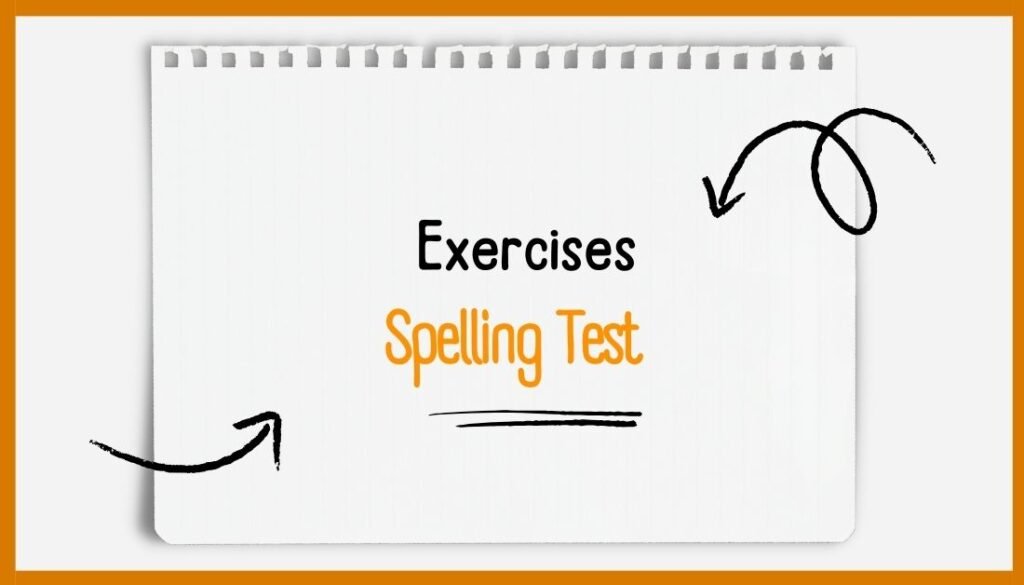
Right! It is time to see how many of these rules you remember. Grab a pen and paper. It is time for a spelling test. [english spelling rules with examples]
Exercise 1: Fill in the gaps or add the suffixes:
- rec__ve
- n__ce
- w__rd
Here are the answers:
- Receive.
- Niece.
- Weird.
The rule is I before E, except after C. Weird is a common exception to the rule because it is weird. It doesn’t follow the rules. Don’t get caught out.
Exercise 2: Add the suffix +-s
- lady
- reply
- key
Answers:
- lady = ladies
- reply = replies
- key = keys
We only change Y into I when we have a consonant + Y, like with the words lady and reply.
Did you remember to add the -ES after the I? The Key ends in a vowel plus Y, so the Y stays.
Exercise 3: Add the suffix: +-er
- help
- run
- open
Answers:
- help = helper
- run = runner
- open = opener
Here rule is: consonant + vowel + consonant + suffix = double the final consonant
So, we double the final consonant in the word run as we have a CVC pattern. Help ends in VCC, and open is stressed on the first syllable, so we don’t double the consonant.
Exercise 4: Add the suffix: +-ful
- hope
- care
- hate
Answers:
- hope = hopeful
- care = careful
- hate = hateful
Here the rule is: we only drop the final ‘e’ when adding a suffix that begins with a vowel. So, ‘e’ is silent.
Exercise 5: Add the suffix: +-al
- remove
- propose
- reverse
Answers:
- remove = removal
- propose = proposal
- reverse = reversal
These words end in a silent ‘e‘, and we’re adding a suffix that begins with a vowel, so the ‘e’ is dropped.
The rule is: if the word ends in a silent ‘e’ and the suffix begins with a vowel, the ‘e’ is dropped. [english spelling rules with examples]
Students also read: Which Grammar is Important to Speak English?